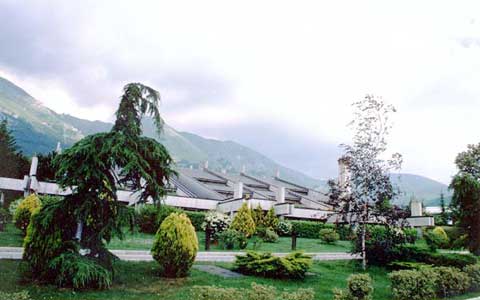
The Gran Sasso National Laboratory (LNGS) is one of four INFN national laboratories.
It is the largest underground laboratory in the world for experiments in particle physics, particle astrophysics and nuclear astrophysics. It is used as a worldwide facility by scientists, presently over 900 in number, from 29 different countries, working at about 15 experiments in their different phases.
It is located between the towns of L'Aquila and Teramo, about 120 km from Rome.
The underground facilities are located on a side of the ten kilometres long freeway tunnel crossing the Gran Sasso Mountain. They consist of three large experimental halls, each about 100 m long, 20 m wide and 18 m high and service tunnels, for a total volume of about 180,000 cubic metres.
The average 1400 m rock coverage gives a reduction factor of one million in the cosmic ray flux; moreover, the neutron flux is thousand times less than on the surface, thanks to the smallness of the Uranium and Thorium content of the dolomite rocks of the mountain.
The headquarters and the support facilities, among which offices, different services, library and canteen, are located in the external building.
The mission of the Laboratory is to host experiments that require a low background environment in the field of astroparticle physics and nuclear astrophysics and other disciplines that can profit of its characteristics and of its infrastructures.
Main research topics of the present programme are: neutrino physics with neutrinos naturally produced in the Sun and in Supernova explosions and neutrino oscillations with a beam from CERN (CNGS program), search for neutrino mass in neutrinoless double beta decay, dark matter search, nuclear reactions of astrophysical interest.
Both the external as well as the underground structures of the National Laboratory of Gran Sasso are located inside the so called Parco Nazionale del Gran Sasso e Monti della Laga.